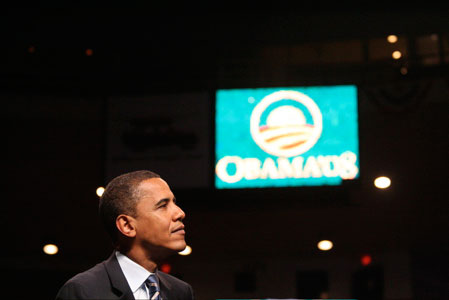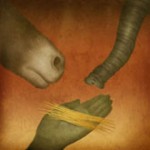A New Democratic Coalition
Can Sen. Barack Obama serve as the FDR of his day?
Jul 31, 20201.8K Shares210.5K Views
In 1932, Franklin D. Roosevelt redefined U.S. politics by forging a dramatically new coalition that ended 12 years of Republican rule and propelled him to the presidency. Seventy-six years later, Illinois Sen. Barack Obama hopes to replicate Roosevelt’s success by forging his own coalition — if one markedly different from FDR’s.
Roosevelt built an alliance that included labor unions, white ethnics (Irish, Italians and Jews), African-Americans, liberal intellectuals, urbanites, Southern whites and, after passage of the Social Security Act in 1935, the elderly. FDR’s New Deal coalition proved powerful enough to enable Democrats to win seven of the nine presidential elections between 1932 and 1964.
Obama has drawn a decidedly different coalition into his campaign: white professionals, Internet activists, independents, disenchanted Republicans and the new technological white-collar workforce—people who tend to vote; and youth, African-Americans and apolitical women—groups who often fail to register but are being persuaded to by Obama and powerful allies like Oprah Winfrey.
Obama’s faithful represent dramatically different groups from FDR’s era — in part because the U.S. economy and workforce are dramatically different. The industrial working class of the 1930s has been supplanted by a new generation of information-technology workers—educated men and women who labor in a wide variety of white-collar information-technology jobs and run many of the Internet websites that have brought him unprecedented campaign contributions.
Illustration by: Matt Mahurin
Yet many now wonder whether the Democratic Party can survive without its traditional base of labor unions, blue-collar white males, white ethnics and old style urban political machines—groups who proved its stronghold during the 1930s, 1940s and 1950s.
That base began crumbling in the mid-1960s, when debates over civil rights and the war in Vietnam drove many Democrats — especially blue-collar workers — into the Republican camp. The New Deal coalition continued deteriorating during the late 1960s and fell apart after the 1968 Democratic convention, when anti-war activists succeeded in setting new quotas for increased minority, youth and female participation in the next convention.
In 1972, after rejecting Old Guard leaders like Hubert H. Humphrey, Edmund Muskie, and Henry “Scoop” Jackson, Democratic delegates—80 percent attending a convention for the first time—nominated George S. McGovern and passed a decidedly Left platform that was anti-imperialist, anti-racist, pro-feminist, pro-abortion and pro-gay rights.
Arguing that Democrats no longer championed values FDR stood for, values that drew together a broad spectrum of middle- and working-class Americans, many longtime liberals and prominent intellectuals left to join the emerging neo-conservative movement. The old New Deal coalition was dead and none has been reassembled since. No wonder Democrats can sometimes look like a party without a center.
Obama stands poised to forge a new Democratic coalition. To win, however, he needs to draw another critical group into his potential alliance, one that could help sweep him into office and keep him there for the next eight years: the 50 percent of the eligible electorate who rarely vote.
Americans have become blasé about voting for national leaders. That was not always the case. From 1840 to 1900, voter turnout in presidential elections ranged from a low of 70 percent to a high of 82 percent.
The second half of 20th century, however, saw a sharp drop in the percentage of citizens who voted. Most presidential elections between 1948 and 1968 attracted only 50 to 60 percent of the eligible voters. From 1972 to 2004, voting percentages averaged 53 percent. Contrast this to the long lines of Venezuelan voters who turned out before dawn several months ago and stood in line for hours to vote down Hugo Chavez’s constitutional amendments.
Why has U.S. turnout been so low? Largely because Americans feel alienated from the political process. Many say they see little real difference between candidates, little real difference between parties and little likelihood that politicians will carry out their campaign promises.
The conventional wisdom among political consultants is that only 50 percent of the eligible population will vote in presidential elections—and of that group, 40 percent vote Democratic and 40 percent Republican. That leaves the election in the hands of the remaining 20 percent of the undecideds. Not surprisingly, recent presidential campaigns focused on winning that 20 percent. Republicans move to the left and Democrats to the right in hopes of winding up somewhere in the seemingly appealing—to the undecideds at least—bland middle.
Things could be different this year if Obama succeeds in adding citizens who do not usually vote to his New Democratic coalition. According to most polls, this group is comprised of blacks, Americans under age 30, the lower middle class, those who never attended college and people who feel they have little grasp of key election issues.
Over the years, many candidates have talked about reaching out to the 50 percent of Americans who feel alienated from the political process — the 50 percent who feel disenchanted, disillusioned and discouraged with politics as usual. However, during this election season, voter turnouts in primaries have been unusually high—record-setting in many states.
Pundits now predict an extraordinarily high turnout this November. If that happens, it will be because many of the 50 percent who never bother have decided to join the national body politic. The discouraged are finally feeling encouraged. Moreover, a large percentage of those new activists are young voters, who feel they can finally make a difference.
What has changed? Three things: charisma, new messages and a powerful ally—Oprah Winfrey.
The first two are familiar to political junkies, but they matter to those who do not usually follow campaigns. In our telegenic age of politics, Obama displays more charisma and screen presence than any candidate since John F. Kennedy. To paraphrase Marshall McLuhan, the medium can be more important than the message. Consider, hose who listened to the John F. Kennedy-Richard M. Nixon debates on radio in 1960 thought the latter won; those who watched it on TV thought Kennedy won. We know who won that November.
Equally important, Obama has excited Americans by moving away from FDR’s interest group politics and embracing a more transcendent message that avoids harsh partisanship and reaches out to a broader range of citizens.
Since the onset of the Cold War, Republicans have often preached the politics of fear and reassurance—of dire foreign threats coupled with reassuring promises to preserve domestic tranquility. Democrats, on the other hand, preached the politics of hope and guilt—of what America could be, but how prejudice and selfishness prevented us from realizing those dreams. Fear and reassurance often proved a greater motivator of voters than hope and guilt.
Obama has now reinvigorated the message of hope by dropping the guilt. Instead, he is focusing on the possibility of change. “Yes we can!” and “Change we can believe in” have become rallying cries for many who never cared much about politics.
Winfrey is another critical part of Obama’s new politics. Celebrities have endorsed political candidates since the 1910s, often with mixed results. In a media-drenched culture, support from a Sean Penn or Barbra Streisand can often hurt a candidate now.
Yet Winfrey’s gravitas and reputation as a serious activist who tries to improve the lives of others is far greater than any contemporary star. Her reach is extraordinary: a television show that attracts 8 million viewers each weekday afternoon; a magazine with a circulation of 2 million; a weekly newsletter sent to nearly a half-million, and 360,000 people who subscribe to her web site for daily “Oprah Alerts.”
Winfrey’s endorsement of Obama in July 2007 marked the first time she has supported a political candidate. Though this will not necessarily make her fans vote for Obama, it will make them pay attention to what he has to say. Once they do, once they no longer feel ignorant about key campaign issues, many could wind up voting for him.
As one Iowa woman told a New York Times reporter, “I’m leaning more towards Obama, and that’s because of both Oprah’s support and what I’ve seen of him.” That Iowan is not the only one affected by Winfrey. Her mere presence at rallies helped draws tens of thousands of people to arenas in Iowa, New Hampshire, California and South Carolina—where Obama had to rent a stadium to satisfy the overwhelming demand to see him and Winfrey.
Many of the 50 percent who never vote are Winfrey’s people—women who feel turned off by politics. Her support of Obama might change the political constellation.
We know from political demographics that women tend to vote Democratic far more heavily than men. If Winfrey can get them to listen — as she seems to have done in the primaries — if she can get 1-2 percent of the non-voters to vote, what we know from the 2000 and 2004 elections is that an increase of 1-2 percent in key states can swing a presidential election.
Indeed, a recent study by two economists contends that Winfrey’s endorsement gave Obama a boost of more than 1 million votes in the primaries and caucuses—nearly 1 percent of the total votes cast in the 2004 presidential elections. This is why Winfrey and her fans can be as powerful as any interest group recruited into FDR’s coalition.
Is this the same Democratic Party as in FDR’s day? Yes and no.
The specific issues and coalition partners have changed, but the core message of Obama’s Democratic Party remains the same as in Roosevelt’s time: more government rather than less.
Though Republicans see government as the problem and not the solution, Democrats continue to promote a strong federal government that acts to protect the interests of the nation’s citizens. Local and state governments, they believe, simply cannot address the complex problems that face a country of more than 300 million people.
Today’s Democrats are no longer the party of Roosevelt or his New Deal coalition. But come November, pundits, academics and citizens could well be talking about Obama’s New Democratic coalition—one powerful enough to change the face of American politics for decades to come.
- Steven J. Ross, professor of history at the University of Southern California. He is now working on a new book, “Hollywood Left and Right: How Movie Stars Shaped American Politics.”*

Hajra Shannon
Reviewer
Latest Articles
Popular Articles

